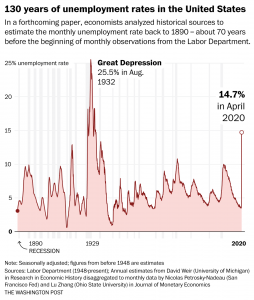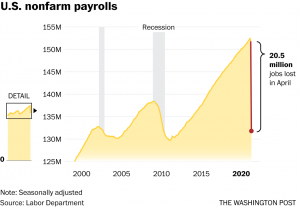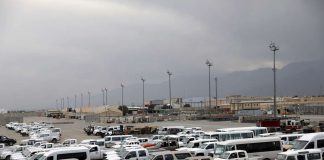MAY 8, 2020

The U.S. unemployment rate jumped to 14.7 percent in April, the highest level since the Great Depression, as most businesses shut down or severely curtailed operations to fight the deadly coronavirus.
Over 20 million people lost their jobs in April, the Labor Department said Friday, wiping out a decade of job gains in a single month. The staggering losses are roughly double what the nation experienced during the 2007-09 crisis, which used to be described as the harshest economic situation most people ever confronted. Now that has been quickly dwarfed by the fallout from the global pandemic.
President Trump and numerous state and local leaders decided to put the economy in a deep freeze in an effort to minimize exposure to the virus. This led businesses to suddenly shed millions of workers at a rapid rate never seen before. Analysts warn it could take many years to return to the 3.5 percent unemployment rate the nation experienced in February.

The sudden economic contraction has forced millions of Americans to turn to food banks and seek government aid for the first time or stop paying rent and other bills. As they go without paychecks for weeks, some have also lost health insurance and even put their homes up for sale.
“This is pretty scary,” said Lindsey Piegza, chief economist at Stifel. “I’m fearful many of these jobs are not going to come back and we are going to have an unemployment rate well into 2021 of near 10 percent.”
Job losses began in the hospitality sector but have quickly spread across the economy. Jobs that are normally considered recession-proof in white-collar businesses and government also have been cut as sales have plunged and state and local governments have faced severe budget shortages. There have even been layoffs in health care, as patients have been putting off things beyond emergency care.
As horrific as the April unemployment figure, economists say the official government rate almost certainly underestimates the extent of the job losses. The Labor Department collected the data in mid-April. Layoffs have continued to mount since then, and the unemployment rate only measures people actively searching for a job, which is difficult during an era when Americans are being encouraged to stay at home.

What’s clear so far from unemployment claims data and polling is that Hispanics, African-Americans and low-wage workers in restaurants and retail have been the hardest hit by the job crisis. Many of these workers were already living paycheck-to-paycheck and had the least cushion before the pandemic hit.
“Low-wage workers are experiencing their own Great Depression right now,” said Ahu Yildirmaz, co-head of the ADP Research Institute, which focuses on the job and wage trends.
While Congress has approved nearly $3 trillion in aid, it’s been slow to arrive for many. Millions are still battling outdated websites and jammed phone lines to try to get unemployment aid and a relief check. Economists are urging Congress to act now to ensure aid does not end this summer when the unemployment rate is still likely to be at historic levels.
“This unemployment rate should be a real kick in the pants — and maybe even the face,” said economist Claudia Sahm, a former Federal Reserve staffer and expert on recessions. “Congress has to stay the course on aid until more people are back at work.”
There’s a growing consensus that the economy is not going to bounce back quickly like Trump wants, even as more businesses re-open this month. Many restaurants, gyms, and other firms are only able to operate at limited capacities, and customers are proving to be slow to return as they are fearful of venturing out. Many businesses also won’t survive. All of this means the economy is going to need far fewer workers for months — or possibly years — to come.
“We’re not going to go sharply down and sharply up. We went sharply down and we’ll go gradually up,” Thomas Barkin, president of the Federal Reserve Bank of Richmond, said Thursday.
Courtesy/Source: Washington Post










































































































